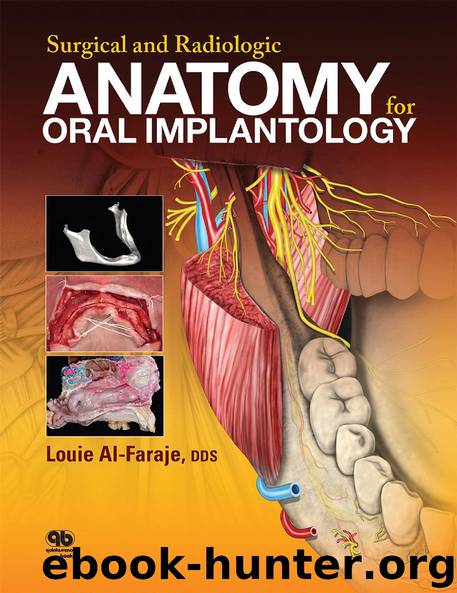Surgical and Radiologic Anatomy of Oral Implantology by Louie Al-Faraje

Author:Louie Al-Faraje
Language: eng
Format: epub
Tags: MED016000, book
Publisher: International Quintessence Publishing Group
Published: 2013-11-16T00:00:00+00:00
Fig 4-16 Al-Faraje classification of bone loss resorption patterns in the anterior maxilla.
Clinical management of maxillary alveolar bone deficiency
The following are basic principles for the management of maxillary alveolar bone deficiency:
• Identification of the exact bone loss pattern on the CT scan.
• For Class I bone resorption (Al-Faraje classification), implants with regular or even wide platform diameters may be placed, because the bone loss is minimal in width and height (recent tooth loss).
• For Class II bone resorption, implants can still be placed without any simultaneous bone grafting procedures; however, the operator should select a narrow platform–diameter implant to ensure adequate thickness of bone on the buccal and palatal sides of the implants.
• For Class IIIA bone resorption, the operator should perform alveoloplasty and then ridge augmentation via the split– cortical technique before the placement of implants, place implants with simultaneous guided bone regeneration, or perform block grafting with delayed implant placement. Although three techniques are available, the ridge splitting is the easiest and the most reliable in this type of maxillary bone loss. Figure 4-17 illustrates the steps of this procedure, and Fig 4-18 shows a clinical example.
• For Class IIIB bone resorption, the splitting technique is not possible, and the block grafting technique is challenging because of minimal host bone thickness; therefore, the recommended procedure is guided bone regeneration using titanium mesh and recombinant human bone morphogenetic protein 2 (rhBMP–2)/absorbable collagen sponge (ACS) grafting material.
• For Class IV bone resorption, three techniques are available for vertical ridge augmentation: block grafting, distraction osteogenesis, and interpositional grafting. Nasal floor elevation may also be indicated with certain height in the anterior region. The operator should choose one of these techniques based on the severity of the resorption and the location of the resorbed ridge (anterior versus posterior).
Download
This site does not store any files on its server. We only index and link to content provided by other sites. Please contact the content providers to delete copyright contents if any and email us, we'll remove relevant links or contents immediately.
Essentials of Biostatistics in Public Health by Sullivan & Sullivan(1112)
Critical Thinking: Understanding and Evaluating Dental Research by Donald Maxwell Brunette(1018)
The Dental Diet by Steven Lin(991)
Basic Biostatistics by B. Burt Gerstman(946)
Tooth Whitening Techniques by Linda Greenwall(936)
One of the Guys by A.R. Perry(933)
0263927350 by A. L. Bird(898)
Cure Tooth Decay: Heal And Prevent Cavities With Nutrition - Limit And Avoid Dental Surgery and Fluoride [Second Edition] 5 Stars by Nagel Ramiel(877)
46 Where There Is No Dentist by Where There Is No Dentist(870)
ACT Prep 2019 by Kaplan Test Prep(866)
Dental Practice: Get in the Game by Michael Okuji(862)
Essential Dental Therapeutics by David Wray(835)
Small Animal Dentistry by Heidi B. Lobprise(825)
Dental Caries by Zhou Xuedong(812)
Bone Biology, Harvesting, Grafting For Dental Implants by Arun K. Garg(808)
Dentistry with a Vision: Building a Rewarding Practice and a Balanced Life by Gerald I. Kendall Gary S. Wadhwa(801)
A Textbook of Dental Homoeopathy by Dr Colin B. Lessell(796)
Fundamentals of Operative Dentistry by James B. Summitt(789)
Uncomplicate Business: All It Takes Is People, Time, and Money by Howard Farran(753)
